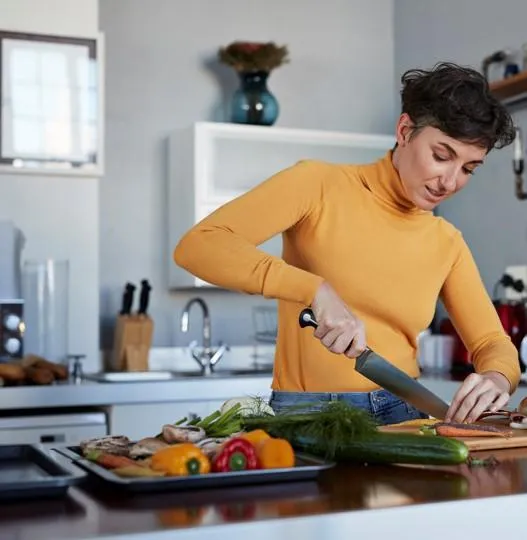
Essential Kitchen Tools
Mastering the Kitchen: Essential Tools
Having the right tools is the first step to becoming a confident and efficient cook. These are the workhorses of any kitchen.

1. Cutting & Chopping
Chef's Knife (8-inch): This is the most important knife you'll own. Invest in a good quality one; it will handle most of your chopping, slicing, and dicing needs.
Tip: Learn proper knife skills for safety and efficiency.
Paring Knife (3-4 inch): Small and nimble, perfect for delicate tasks like peeling small fruits, coring tomatoes, or mincing garlic.
Serrated Knife (Bread Knife): Many think this knife is essential so I've kept it on the list. It is used for slicing bread, tomatoes, and other foods with soft interiors and tough exteriors without crushing them. I have found with a good chef's knife that is kept sharp, you won't need this knife. Instead I would invest in a utility knife, and a knife sharpener.
Cutting Boards (at least 2):
Recommendation: One larger for general prep (wood or durable plastic), and one smaller, possibly for raw meat only, to prevent cross-contamination.
Tip: Place a damp paper towel or non-slip mat underneath for stability.
Kitchen Shears/Scissors: Versatile for cutting herbs, trimming poultry, opening packages, and more.
2. Measuring & Mixing
Dry Measuring Cups (set of 4-6): For flour, sugar, and other dry ingredients. Look for ones that nest for easy storage.
Measuring Spoons (set of 4-6): For smaller amounts of ingredients (teaspoons, tablespoons).
Liquid Measuring Cups (glass, 2-cup and 4-cup): Clear glass cups with spouts are best for accurately measuring liquids at eye level.
Mixing Bowls (set of 3-5, various sizes): Stainless steel or glass are durable and versatile. Nested sets save space.
Whisk (medium size): For whisking eggs, sauces, vinaigrettes, and batters.
Rubber/Silicone Spatulas (various sizes): Flexible spatulas are essential for scraping bowls clean, folding ingredients, and stirring hot foods without scratching non-stick pans.
3. Cooking & Bakeware
Non-Stick Frying Pan (10-12 inch): A must-have for eggs, pancakes, delicate fish, and foods that tend to stick.
Stainless Steel Skillet/Sauté Pan (10-12 inch): Great for searing, browning, and achieving a good crust on meats and vegetables. Can go from stovetop to oven. I actually now prefer a cast iron skillet. All the same benefits with a slight non-stick quality to it if you care for it well.
Saucepan with Lid (2-3 quart): For making sauces, boiling eggs, cooking grains, and reheating small portions.
Stock Pot with Lid (6-8 quart): For soups, stews, pasta, boiling larger quantities of water, and making stock.
Baking Sheets/Sheet Pans (2 large, rimmed): Incredibly versatile for roasting vegetables, baking cookies, toasting nuts, and more.
Glass Baking Dish (9x13 inch): For casseroles, roasted chicken pieces, brownies, and other baked dishes.
4. Utensils & Gadgets
Tongs (12-inch, with silicone tips): Your "extended hands" in the kitchen. Perfect for flipping, turning, serving, and grabbing hot items. Silicone tips protect non-stick pans.
Spatulas/Turners (Metal and Silicone/Nylon):
Metal Spatula/Fish Spatula: Thin, flexible, and strong for easily sliding under foods.
Silicone/Nylon Turner: Safe for non-stick pans.
Wooden Spoons (2-3, various sizes): Gentle on cookware, heat-resistant, and good for stirring.
Slotted Spoon: For lifting solid foods out of liquids.
Ladle: For serving soups, stews, and sauces.
Can Opener (manual): A reliable, sturdy one is key.
Vegetable Peeler (Y-peeler or swivel): For quickly peeling vegetables and some fruits.
Colander/Strainer: For draining pasta, washing produce, and rinsing canned goods. A fine-mesh strainer is also useful for sifting or straining sauces.
Grater (Box Grater or Microplane): For cheese, vegetables, and citrus zest. A Microplane is excellent for fine zesting and grating garlic/ginger.
Instant-Read Meat Thermometer: Crucial for food safety and ensuring meats are cooked to the perfect doneness. A game-changer for avoiding dry chicken!
5. Safety & Storage
Oven Mitts/Pot Holders: Essential for handling hot items safely.
Food Storage Containers: For leftovers, meal prep, and pantry organization. Glass containers are durable and microwave/oven-safe.
This list gives you an excellent foundation for outfitting your kitchen! Key things to remember:
Buy for Versatility: Prioritize tools that serve multiple purposes. Specialized tools often end up being relegated to tomorrow's donation pile.
Quality Over Quantity: It's better to have a few good, sharp knives and sturdy pans than a drawer full of flimsy gadgets.
Maintenance Matters: Treat you equipment well and they will last a lifetime, e.g., handwashing good knives, seasoning cast iron.
Building a Collection: Start with the absolute basics and add more tools as your skills and interests grow. My rule of thumb is I don't buy a specialized tool until it's needed for a meal I'll cook more than once.
Safety First: Learn knife safety, be careful of hot pans, and watch the food temperature.